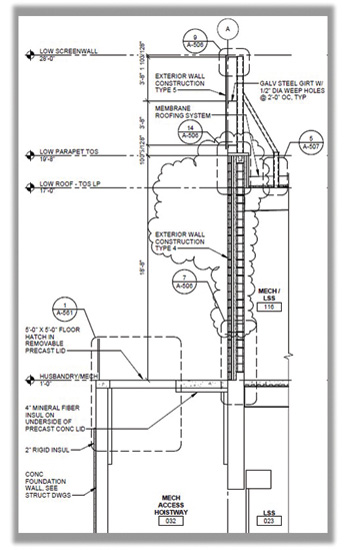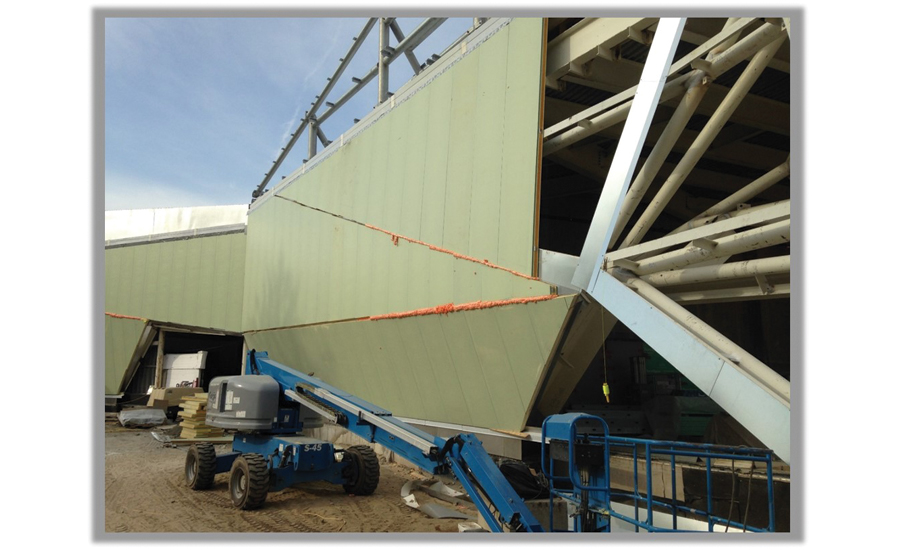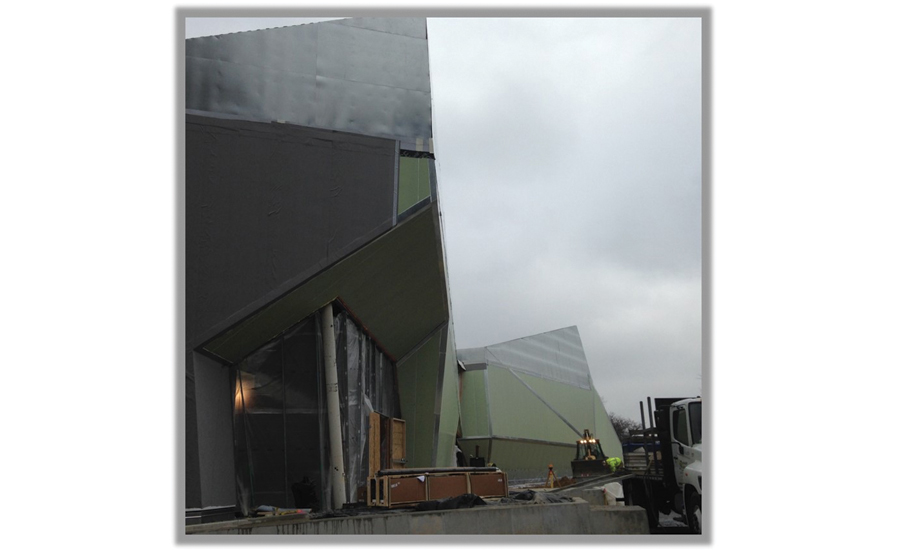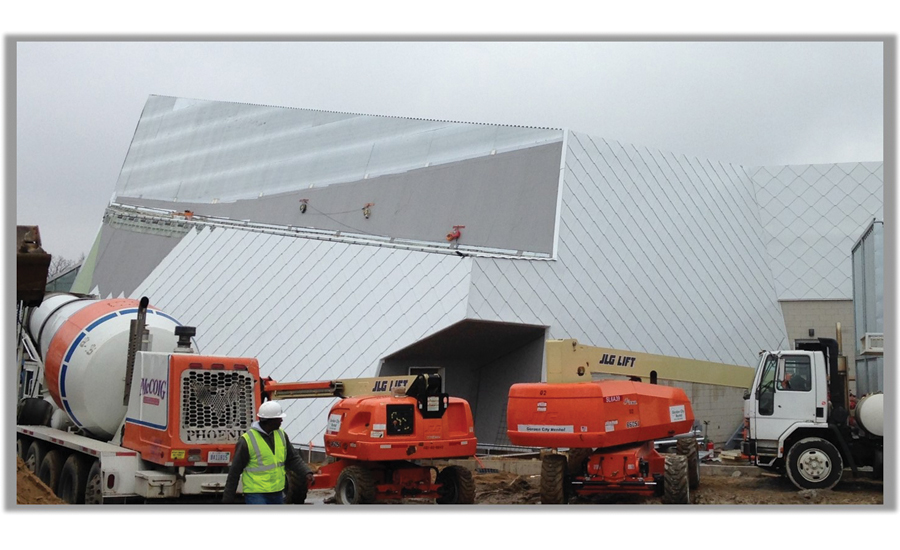High-Performance Building Enclosure Design for a Net-Zero Ready Habitat for Sub-Zero Wildlife
The Walls
Five different wall types were used in the PPCC enclosure design, depending on their location and the user—penguin or human. A basic wall design was determined and then modified depending on the location. The layered rainscreen wall design is comprised of metal panels as “shingles” with a -inch air gap. Then there is a peel-and-stick waterproof member that self-heals around the anchors to prevent any thermal or vapor transmission. Finally, this was all installed over 4-inch insulated panels.
The wall works even when the panel heats up in the sun. The 1/4-inch air gap, present from bottom to top of the wall, uses stratification to naturally carry the heat up to the top and then dissipate out. This prevents the waterproof membrane and insulation panels from heating up too much in warm/hot weather and keeps the penguin habitat cool. The five types of walls and where they were used are:
For the main penguin habitat, the walls were composed of:
- Exterior metal wall tile
- On underlayment material
- On 4-inch insulated metal wall panel
- On steel girts
- Waterproofing membrane
Walls above the roof were composed of:
- Exterior metal wall tile
- On 11/2-inch metal wall panel
- On steel girts
- Waterproofing membrane
Walls below the roof in the staff areas to the back (north) and the west and east walls were composed of:
- Exterior metal wall tile
- On 11/2-inch metal wall panel
- On CFMF girts
- On 21/2-inch foam-in-place insulation
- On 8-inch CMU (or concrete wall at trickling filter)
- Waterproofing membrane
Walls on the north side in the staff areas were composed of:
- 4-inch burnished CMU
- On 21/2-inch foam-in-place insulation
- On 8-inch CMU (or concrete wall at trickling filter)
- Waterproofing membrane
And lastly, the parapet walls that shade the roof over the penguin habitat were composed of:
- Perforated corrugated metal panel with vertical flutes on steel girts
- Waterproofing membrane
Figures 3 and 4 show cross-section designs of two wall types. Figure 3 shows the enclosure at the lobby and above the penguin habitat. On the lower portion, there is glazing and an overhang to prevent heat gain in the summer months. The overhang is insulated with the tile wall, an air gap and the metal panel. Once the wall goes above the roof (upside down V shape), that portion is either metal tile on the panel or just a metal panel. This wall design helped determine the shape of the roof over the penguin habitat to prevent heat. Even though the roof is white to reflect heat, it needed to be shaded to limit the heat gain on the roof and minimize the need to cool.
Figure 4 shows the north or back side of the facility where the staff and animal husbandry rooms are located. Here is the CMU wall with insulation plus another CMU wall. There are two walls in this section. The animal husbandry rooms had to be separated from the rest of the staff area because the temperature in these special rooms must range from 37 F to the 70s depending on how the room is used—either to incubate the penguin eggs or acclimate the young birds to the cold habitat environment.


Illustrations courtesy of Albert Kahn Associates Inc.
Figure 3 (left): Enclosure wall design at the lobby and above the penguin habitat.
Figure 4 (right): Two walls were used in the animal husbandry area, to ensure control of their wide range on temperature requirements.
Other Enclosure Elements
Glazing was limited to the south face of the PPCC. It’s a typical 1-inch glazing unit with low E coating with low reflectivity, bird strike prevention and fritting. This helps limit heat gain, as well as prevent birds from hitting the building. Also, the building shape itself shades the glazing.



Photos courtesy of Albert Kahn Associates Inc.
This series of photos show the enclosure being constructed.
Top: First, insulation panels are going up and being sealed off in between the panels.
Middle: Next, the waterproof membrane is installed over the top of the panels.
Bottom: Lastly, the metal tiles are installed over the membrane.
Skylights were required to provide the penguins with UV light. In order to limit the heat gain from the skylights, they slope to the north, limiting the amount of direct sunlight. They vary in depth to limit heat gain. The scrim diffuses the light and decreases the amount of harmful infrared rays entering the penguin habitat.
The roof is white thermoplastic polyolefin single-ply membrane with 8-inch minimum tapered insulation, vapor barrier and sheathing. It has the continuous insulation that is used throughout the entire building including underneath the slab. In a typical zone, the vapor barrier is located at the bottom of the insulation. But the penguin habitat zone was handled differently. Based on dew point calculations, a 4-inch vapor barrier is used above the insulation to prevent a dew point from the interior ceiling space above the animal habitat. This was necessary to avoid water dripping from the ceiling and potentially harming the building materials. Dew point calculations are very important in determining the placement of the vapor barrier.
The Wrap Up—Conclusion
When designing a high-performance building enclosure there are several key things to remember:
- Continuous insulation and air barriers will help you create a high-performance building, but they must be properly located. And don’t forget about the ground. As in the PPCC, with a pool you must prevent heat transmission from the ground.
- You must always identify and design for the unique functions and features of the building. Look at the primary building use, but every building will have unique features and you must understand how they will affect overall building performance.
- Use passive design as much as possible. This helps limit the initial costs of the mechanical units and their operational and maintenance expenses, as well as energy-use costs.
- Don’t forget about commissioning and metering properly. If this is not done thoroughly and accurately, you will waste more energy than you should. The additional cost of installing the right number of meters up front will be returned multiple times in energy-cost savings over the life of the building.
References
- Building Enclosure Technology and Environmental Council. (2016). Facility performance & sustainability. Retrieved from National Institute of Building Sciences: http://www.nibs.org/betec
- Building Enclosure Technology and Environmental Council. (2016). Building enclosure design guide. Retrieved from National Institute of Building Sciences: https://www.nibs.org/?page=hpbc
- Higgins, C. & Harris, D. P.E. (2013, September). Energy management trends: The power of plugs. Today’s Facility Manager. Retrieved from http://facilityexecutive.com/2013/10/energy-management-trends-power-plugs/
- Lobell, S. (Spring 2016). World’s largest penguin facility counts on condensing boiler. Today’s Boiler. Retrieved from http://www.abma.com
- National Institute of Building Sciences. (2016). Energy Independence and Security Act of 2007. What is a high performance building? Retrieved from http://nibs.org/?page=hpbc
- National Renewable Energy Laboratory. (2016). What is a high performance building? Retrieved from http://www.nrel.gov
- Office of Energy Efficiency & Renewable Energy. (2015, September). DOE releases common definition for zero energy buildings. Retrieved from Department of Energy: http://energy.gov/eere/buildings/articles/doe-releases-common-definition-zero-energy-buildings-campuses-and
- Passive Solar Design. (2016). Definition of passive design. Retrieved from http://passivesolar.sustainablesources.com
Anthony Offak is a registered architect in Michigan, holds a Bachelor of Architecture degree from University of Detroit Mercy and is a member of USGBC Detroit Regional Chapter. He joined Albert Kahn in 2000 as a Project Manager for the firm’s Automotive/Industrial team. His background in tracking and management of data is foundational to his contributions to the firm and his roles as project architect and project designer. His oversight of 3D BIM integration into projects combined with commitment to sustainable practices in building design are some of his many contributions to Kahn. Most notably he has been involved with multiple LEED projects, some that were pioneering projects such as the first LEED Gold Hospital in Brazil and the first LEED Silver Hospital in Wisconsin.

|
IMETCO (Innovative Metals Company, Inc.) is a leading manufacturer of premier metal products for the building envelope, delivering performance-inspired solutions tailored to every project. For more information, visit www.imetco.com or call 800-646-3826. |








